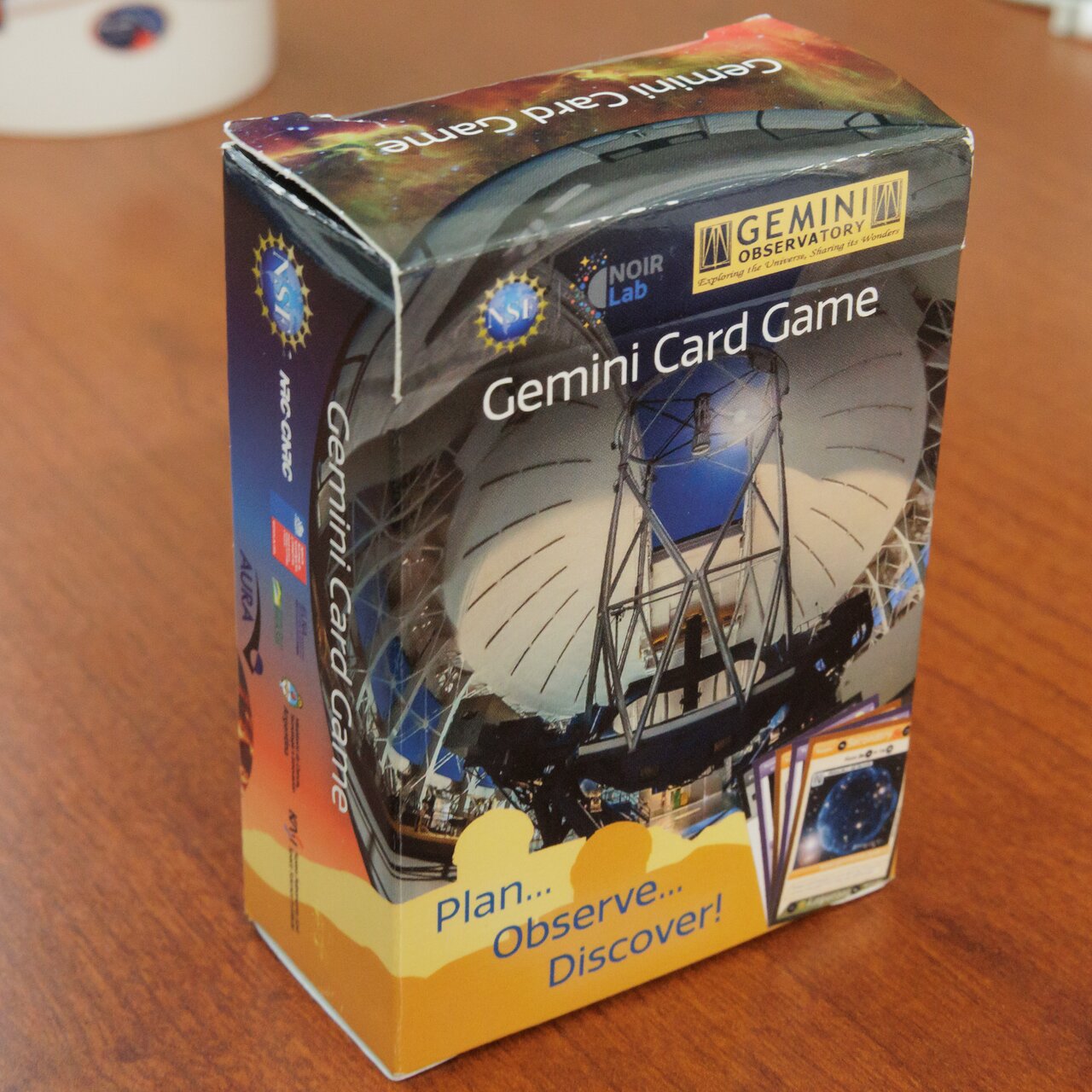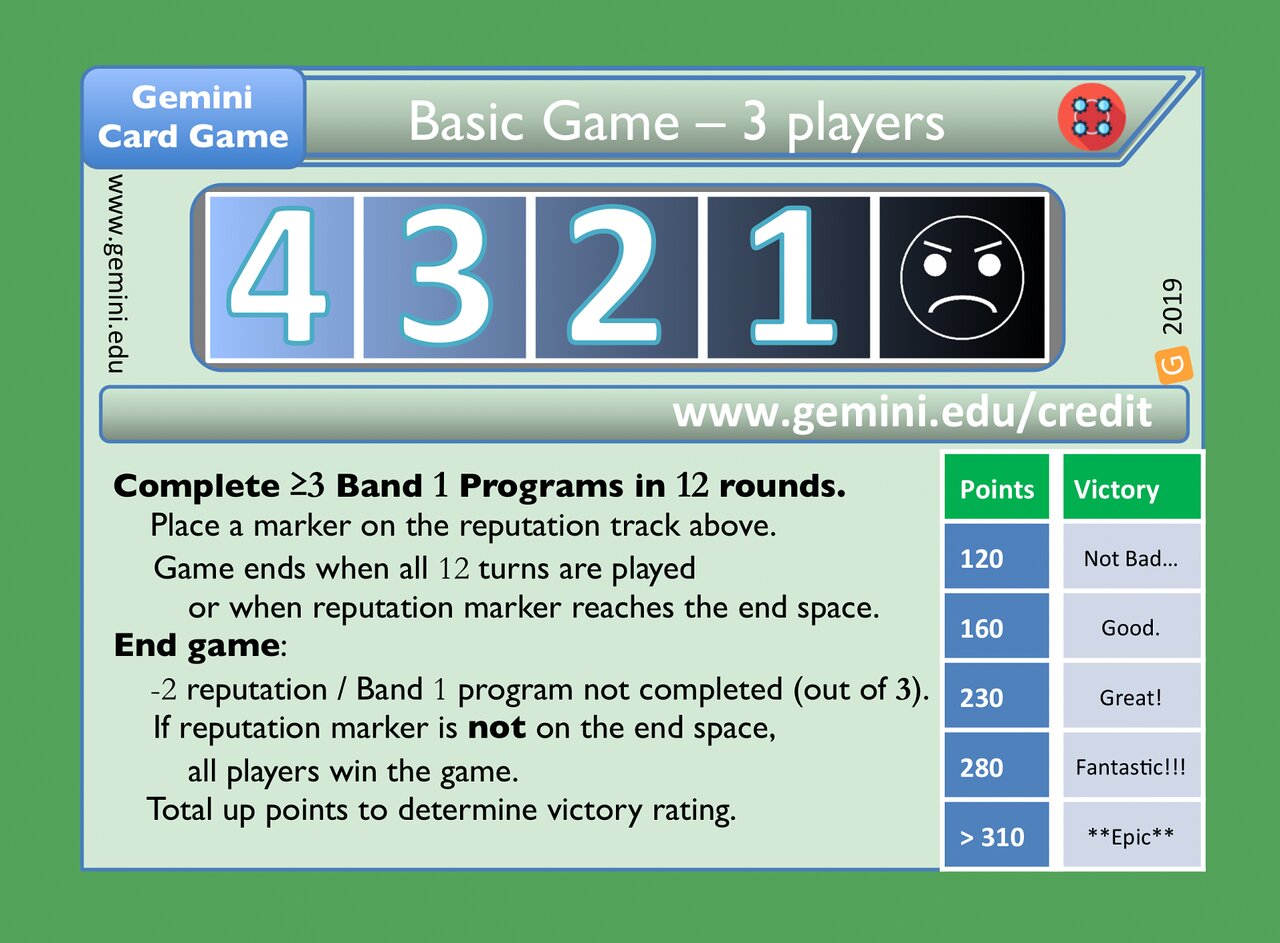Educational Material: The Physical Gemini Card Game
Gemini Card Game played in person
Would you like to play the Gemini Card Game with physical cards? This page is for you!
If you do not know the rules yet, download the rule book! Please read and use this manual. It looks better printed in booklet form! If anything is unclear, or inconsistent, or for any suggestions, please email andre-nicolas.chene@noirlab.edu.
If you have an official card deck...
Please register your deck. You will get (infrequent) updates of the rules, and alerts when expansion sets and booster packs are available!
Errata and rule changes!
Please, consider these changes for the 2019 Basic Deck:
1. Mistake in the scenario card.
Unfortunately, the scenario card was printed with the "2 or 4 player" scenario on both sides. The 3-player scenario should be like this:
2. Extra card in 3-player mode
It is now recommended to add one card in everyone's hand when playing with 3 players. A full hand is therefore 6 cards, unless someone's ability already allows for more cards, in which case it is the number of card for a full hand plus 1 (e.g., 6+1=7).
3. Moving Altair to an instrument does not require action
Altair can now be moved to a "compatible" instrument (i.e., NIRI, GNIRS, or NIFS) without requiring an action from a player. Still, if the instrument is moved to another program, Altair has to be discarded and placed at the bottom of the instrument deck.
If you do NOT have a deck yet and want to play the physical game...
Download a full deck to print at home! Here are the instructions to create a full 90-card basic deck:
- Print one of each of the Instrument cards (pages 6-13).
- Print one of each of the Target cards (pages 27-45).
- Print one of each of the Time cards (pages 46-70).
- Print one of each of the Program cards (pages 14-26). Make the Checkouts and the Poor Weather cards the two sides of a same card.
- For the Weather cards (pages 79-87).
- print 2 "Best" weather cards,
- print 1 "Great" weather card with a red border,
- print 4 "Great" weather cards (no red border),
- print 4 "Good" weather cards,
- print 4 "Poor" weather cards,
- print 1 Earthquake card, 1 Storm card, 1 Shutdown GN card, and 1 Shutdown GS card.
- Print one of each of the Role cards (pages 71-78). Make:
- the 1st and the 2nd cards the two sides of a same card,
- the 3rd and the 4th cards the two sides of a same card,
- the 5th and the 6th cards the two sides of a same card, and
- the 7th and the 8th cards the two sides of a same card
- Optionally, you can print the Reference+Rules cards (pages 1-5).
One trick is to print them on paper, cut them, and place them into play card sleeves. To obtain the right dimensions, you can print 6 cards per US letter-size paper using the portrait orientation. In Acrobat, you can select the option "Multiple" under Page size & Handling. If available, choose the option "fit to printable area." Use transparent card sleeves to make the double-sided cards. Use (or make) different backs for the different decks. Those are the Instruments, Weather, and Player (Time, Target, and Programs) decks (see the video below).
Enjoy!
Short video tutorial
How does it compare to reality?
Of course, it is just a game. At best, it is a simplistic model of the decision-making in place when the Gemini staff is scheduling and observing programs. Also, if 12 rounds is a semester, it means that each round is 2 weeks, and one should expect much more telescope time to be used in real life.
However, Band 1 programs take absolute priority, as they were estimated by peers to be the best use of the telescope time. Band 2 programs are preferable when there are no possibility to observe Band 1 programs. And Band 3 programs are essentially fillers, so good science may be possible when the weather is bad, or when nothing else is available.
Also, deciding on which target to observe is not always straightforward. Observing a setting target instead of a higher priority one, with the hope to catch that other target later is sometimes the best strategy.
Discover a support astronomer experience that is not too far from what really happens in Hilo and La Serena, and share it with us!
Acknowledgments
We would like to thank Mark Rawlings, Graham Bell, Ryan Berthold, Eileen Gonzalez, Paige Godfrey, and the Gemini North Game Club for their precious help with setting up the rules.
Créditos:International Gemini Observatory/NOIRLab/NSF/AURA/A.-N. Chené
About the Education Material
| Id: | edu007 |
| Release date: | 18 de Marzo de 2023 a las 10:04 |

